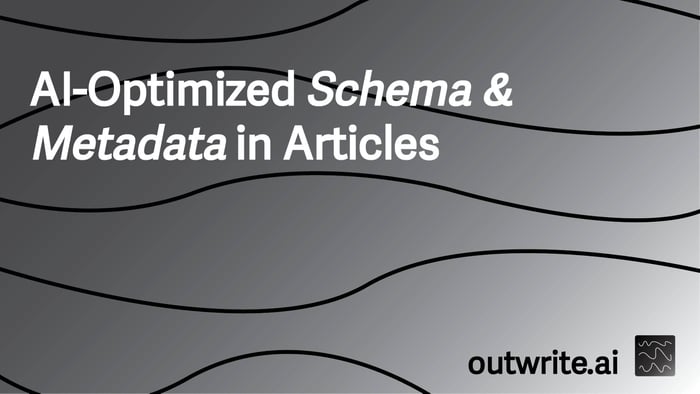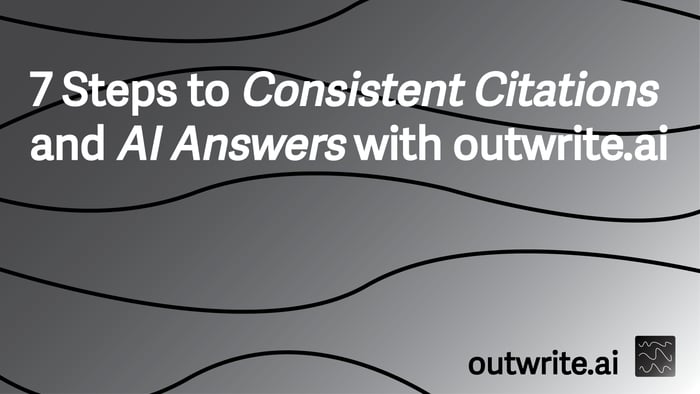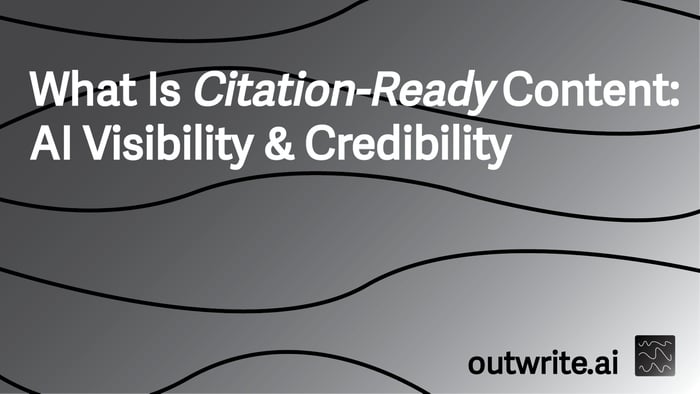Table of Contents
Foundations of AI Optimization
Incorporating AI-optimized schema and metadata into articles is crucial for enhancing visibility and interpretability by search engines and AI models. This process involves structuring content in a way that AI can easily understand, categorize, and present. The goal is to make content machine-readable, moving beyond traditional SEO to AI SEO.
The global AI market is valued at about $391 billion in 2025, growing at a CAGR of 31.5%. This growth drives the rapid adoption of AI-optimized metadata solutions across industries. Metadata acts as the blueprint for AI systems, essential for AI agents to interpret, adapt, and scale across datasets. This enhances automation, personalization, and decision-making in business contexts, as highlighted by Salesforce.
What is AI-Optimized Metadata?
AI-optimized metadata refers to structured information about an article designed specifically for consumption by artificial intelligence. It goes beyond basic SEO meta tags to provide rich, semantic context. This context helps AI models understand the nuances, relationships, and intent behind content.
- Semantic Context: Metadata provides meaning to data, helping AI understand what an article is truly about.
- Machine Readability: It structures information in a format AI can process efficiently, like JSON-LD.
- Enhanced Discoverability: AI uses this data to match content with complex user queries, including conversational searches.
- Improved Interpretability: Clear metadata helps AI systems explain why certain content is relevant.
Why is AI Optimization Necessary Now?
The rise of generative AI and answer engines changes how users find information. AI models like ChatGPT and Perplexity rely on understanding content deeply, not just keyword matching. Articles need to be structured for LLM discoverability, combining structured schema markup, prompt-based content, and clean code for AI parsing. This ensures content is not only found but also cited accurately by AI. To understand how schema markup directly influences LLM citation and AI answer inclusion, you can refer to this detailed guide.
Without AI-optimized metadata, articles risk being overlooked by these new search paradigms. This means lost traffic, reduced authority, and missed opportunities for engagement. The shift emphasizes the importance of metadata quality for reliable outputs, as seen in emerging tools targeting LLM evaluation and trustworthiness for generative AI pipelines, according to lakeFS.

Semantic Data Schemas and Knowledge Graphs
Semantic data schemas, particularly those defined by Schema.org, form the backbone of AI-optimized content. These schemas provide a standardized vocabulary for describing entities, relationships, and actions on the web. When applied to articles, they help AI understand the content's subject matter, author, publication date, and other critical attributes.
The use of standard data schemas and open knowledge bases, such as Schema.org and Wikidata, combined with knowledge graphs, enables more intelligent and accurate conversational AI. This approach facilitates "plug-and-play" solutions for articles and content without increasing complexity or cost, as noted by RTInsights. Enterprises increasingly invest in knowledge graph infrastructures to support semantic AI, realizing higher ROI by enabling deeper insights and automated processes.
Understanding Schema.org
Schema.org is a collaborative effort to create structured data markups that search engines understand. For articles, specific schema types are highly relevant:
- Article Schema: Describes news articles, blog posts, and reports. Properties include headline, author, date published, and image.
- FAQPage Schema: Structures question-and-answer pairs, making them eligible for rich results and direct answers in search.
- HowTo Schema: Details step-by-step instructions, useful for guides and tutorials.
- Review Schema: Marks up reviews of products, services, or creative works.
These schemas provide a common language for webmasters and search engines. By using them, you signal to AI exactly what your content is about, improving its chances of being featured in rich snippets or directly answered by generative AI.
The Role of Knowledge Graphs
Knowledge graphs are interconnected networks of entities and their relationships. They provide a semantic layer that AI models use to understand context and make connections between pieces of information. For articles, a knowledge graph can link an author to their other works, a topic to related concepts, or a product to its specifications.
Integrating articles into a knowledge graph enhances their discoverability and utility for AI. For example, if an article discusses "AI technology trends," a knowledge graph can link this to specific AI technologies, companies, and historical data. This rich context helps AI provide more comprehensive and accurate answers to user queries. The InfoQ AI, ML and Data Engineering Trends Report 2025 emphasizes the importance of knowledge graphs in AI data management.
Benefits of Semantic Schemas and Knowledge Graphs
- Improved Search Visibility: Rich snippets and enhanced search results increase click-through rates.
- Better AI Understanding: AI models can process and interpret content more accurately.
- Enhanced User Experience: Users receive more direct and relevant answers from AI assistants.
- Data Interoperability: Standardized data allows for easier integration with other systems and platforms.
AI-Assisted Metadata Automation
Manually creating and maintaining schema and metadata for a large volume of articles is time-consuming and prone to error. AI-assisted metadata automation addresses this challenge by using machine learning to generate, validate, and update metadata automatically. This approach significantly improves efficiency and accuracy.
Modern AI-assisted metadata frameworks automate metadata generation, enhance governance, and improve dataset accessibility. This is seen as critical for next-gen AI applications and data management, according to research published on arXiv. These frameworks can analyze content, identify key entities, and suggest appropriate schema markup, reducing manual effort and ensuring consistency.
How AI Automates Metadata Generation
AI models, particularly Natural Language Processing (NLP) systems, can read and understand article content. They can then extract relevant information and map it to predefined schema properties. This process involves several steps:
- Content Analysis: AI scans the article to identify topics, entities (people, organizations, locations), and key concepts.
- Entity Recognition: It extracts specific names, dates, and facts that can populate schema fields.
- Schema Mapping: The extracted data is then structured into the appropriate Schema.org types, such as Article, Person, or Organization.
- Validation: AI tools can also check the generated schema for errors against Schema.org guidelines.
For example, an AI could read an article about "AI technology solutions" and automatically identify the author, publication date, and main topic, then generate the corresponding JSON-LD. This automation is crucial for scaling content operations while maintaining high metadata quality.
Tools and Platforms for Automation
Several tools and platforms offer AI-assisted metadata automation. These range from plugins for content management systems to standalone AI services. They help streamline the process of creating and managing structured data.
| Tool Category | Functionality | Example | Benefit |
|---|---|---|---|
| CMS Plugins | Integrate schema generation directly into WordPress, etc. | Yoast SEO, Rank Math | Ease of use, direct integration |
| Standalone AI Services | Advanced NLP for complex content analysis and schema generation | Google Cloud AI, IBM Watson | High accuracy, custom models |
| Schema Generators | Web-based tools to create JSON-LD from input fields | Schema.dev, Merkle's Schema Markup Generator | Quick generation, validation |
These tools reduce the technical burden of implementing schema, making it accessible to content creators and marketers. They ensure that even complex automated content optimization using AI for schema and metadata is handled effectively.
Challenges in Automation
While automation offers significant benefits, it also comes with challenges. Ensuring the AI accurately interprets nuances in language, especially for highly specialized or creative content, requires careful training and oversight. Human review remains important to catch errors and ensure the metadata truly reflects the article's intent.
Another challenge is keeping up with evolving schema standards and AI models. Continuous monitoring and updates are necessary to maintain the effectiveness of automated systems. The arXiv paper on Metadata Management for AI-Augmented Data Workflows discusses these challenges in depth.

Implementing Structured Data for AI
Implementing structured data effectively requires a systematic approach. It is not just about adding a few lines of code; it involves understanding your content, choosing the right schema types, and ensuring correct implementation. This section guides you through the practical steps.
As nDash.com states, "AI-friendly schema is an essential part of the digital marketer’s toolkit. Structured data clearly communicates the content of your webpage to search engines, leading to improved visibility and higher click-through rates." This underscores the importance of precise implementation.
Choosing the Right Schema Types
The first step is to identify the most appropriate Schema.org types for your articles. This depends on the nature and purpose of your content:
- For informational articles, news, or blog posts: Use Article, NewsArticle, or BlogPosting.
- For how-to guides or tutorials: Implement HowTo schema, detailing steps, tools, and materials.
- For Q&A content or FAQs: Utilize FAQPage schema to structure questions and answers.
- For product reviews or comparisons: Apply Review or Product schema.
Combining multiple schema types, such as Article with Author or Organization, provides a more comprehensive view of your content. This helps AI models draw richer connections.
JSON-LD: The Preferred Format
JSON-LD (JavaScript Object Notation for Linked Data) is the recommended format for implementing structured data. It is easy to add to the <head> or <body> of an HTML document and is readily consumed by search engines and AI. Unlike microdata or RDFa, JSON-LD does not require altering the visible HTML content, making it cleaner and simpler to manage.
An example of basic Article schema in JSON-LD:
{ "@context": "https://schema.org", "@type": "Article", "headline": "AI-Optimized Schema & Metadata in Articles", "image": [ "https://example.com/photos/1x1/photo.jpg", "https://example.com/photos/4x3/photo.jpg", "https://example.com/photos/16x9/photo.jpg" ], "datePublished": "2025-11-04T08:00:00+08:00", "dateModified": "2025-11-04T09:20:00+08:00", "author": { "@type": "Person", "name": "Eric Buckley" }, "publisher": { "@type": "Organization", "name": "outwrite.ai", "logo": { "@type": "ImageObject", "url": "https://outwrite.ai/lovable-uploads/f13767c5-9078-47c8-bdcc-892c79fed462.png" } }, "description": "This guide explores the most effective ways to incorporate AI-optimized schema and metadata into articles, enhancing search visibility and AI interpretability." }
Validation and Monitoring
After implementing schema, validation is a critical step. Tools like Schema.org's validator or Google's Rich Results Test help ensure your markup is correct and error-free. These tools identify syntax issues and missing required properties, preventing common mistakes.
Post-implementation, monitoring performance through Google Search Console is essential. It provides insights into how your structured data is being interpreted and if it's generating rich results. This feedback loop helps refine your schema strategy over time.

Metadata Quality and AI Interpretability
The effectiveness of AI-optimized schema and metadata hinges on its quality. Poor quality metadata can confuse AI models, leading to inaccurate interpretations or missed opportunities for visibility. High-quality metadata, conversely, enhances AI interpretability, allowing models to understand content deeply and provide precise responses.
Metadata is described as the “blueprint” for AI systems, essential for AI agents to interpret, adapt, and scale across datasets. This enhances automation, personalization, and decision-making in business contexts, according to Salesforce. The shift in AI data engineering emphasizes LLM accuracy, monitoring, and the importance of metadata quality for reliable outputs, as seen in emerging tools targeting LLM evaluation and trustworthiness for generative AI pipelines, as reported by lakeFS.
Characteristics of High-Quality Metadata
High-quality metadata possesses several key characteristics that make it valuable for AI systems:
- Accuracy: Metadata must precisely reflect the content it describes. Incorrect dates, authors, or topics mislead AI.
- Completeness: All relevant schema properties should be populated. Missing information creates gaps in AI's understanding.
- Consistency: Use consistent terminology and formatting across all articles. Inconsistencies hinder AI's ability to categorize and relate content.
- Granularity: Provide sufficient detail without over-complicating. For example, specify not just "author" but also "author's URL" or "author's social profile."
- Timeliness: Keep metadata updated, especially for time-sensitive content.
These characteristics ensure that AI models receive clear, unambiguous signals about your content, leading to better processing and presentation.
Impact on AI Interpretability
AI interpretability refers to the ability to understand why an AI model made a particular decision or prediction. High-quality metadata directly contributes to this by providing a transparent view of the data an AI uses. When an AI cites an article, the rich metadata explains its relevance.
For example, if an AI answers a query about "AI technology best practices," and cites an article, the associated schema (e.g., Article, author, datePublished) helps the AI justify its choice. This transparency builds trust and improves the overall user experience. Evaluations of AI-generated metadata following standards like Dublin Core, MODS, MARC, and BIBFRAME show improvements in metadata quality when AI models are integrated with domain-specific schemas, according to research from Publicera.
Strategies for Maintaining Metadata Quality
- Regular Audits: Periodically review your schema markup for accuracy and completeness.
- Automated Validation: Integrate schema validation tools into your content publishing workflow.
- Content Guidelines: Establish clear guidelines for content creators on how to provide information for metadata.
- Feedback Loops: Monitor search console reports and AI performance metrics to identify areas for improvement.
These strategies ensure that your metadata remains a valuable asset for AI optimization, not a liability. For a deeper dive into structuring content for maximum visibility and citations, consult this AI SEO blueprint.
Case Studies and Real-World Applications
Examining real-world examples demonstrates the tangible benefits of integrating AI-optimized schema and metadata. These case studies highlight how businesses achieve improved visibility, traffic, and conversion rates by strategically structuring their content for AI.
The effectiveness of AI technology solutions is evident in companies that prioritize structured data. These examples provide practical insights into successful implementation strategies.
Broworks: Answer Engine Optimization Success
Broworks implemented custom schema markup across all key landing pages, case studies, and blog posts. Their strategy focused on optimizing for AI-driven answer engines like ChatGPT, Claude, and Perplexity. By restructuring their site for LLM discoverability, they combined structured schema markup with prompt-based content and clean code for AI parsing.
- Results: 10% of their organic traffic now comes from generative engines.
- Conversion: 27% of that generative engine traffic converts into Sales Qualified Leads (SQLs).
- Key Takeaway: Tailoring content with specific schema for AI answer engines directly translates to measurable business outcomes.
The Search Initiative: Organic Traffic Growth
The Search Initiative built topical authority through clustered supporting content, optimized on-page elements, and restructured site architecture for improved crawlability. They implemented structured data for rich results and launched a focused link-building strategy. Their approach included analyzing top-ranking SERP content for each keyword and aligning content format and purpose to match user expectations.
- Results: Achieved over 3,000% growth in organic traffic.
- Ranking: Secured top-ranking keywords across their target niches.
- Key Takeaway: A holistic SEO strategy that includes structured data and AI-friendly content formats drives significant organic growth.
Exxact Blog: Improving Model Accuracy with Metadata
Exxact Blog trained a sentiment analysis model on a dataset both with and without metadata. The metadata included verification status, review length, and product rating. This experiment demonstrated the direct impact of metadata on AI model performance.
- Without Metadata: Model accuracy was 0.50.
- With Metadata: Model accuracy improved to 1.00.
- Key Takeaway: Enriching datasets with relevant metadata (customer demographics, language identification, temporal information, product ratings) significantly improves AI model accuracy and robustness.
These examples illustrate that AI technology best practices, when applied to schema and metadata, yield substantial benefits across various business objectives.

Strategies for AI-Friendly Content
Creating AI-friendly content goes beyond just adding schema. It involves a holistic approach to content creation, structure, and ongoing maintenance. These strategies ensure your articles are not only discoverable but also highly valuable to AI models.
The goal is to produce content that AI technology can easily process, understand, and present as authoritative answers. This requires a shift in how content is planned and executed.
Content Structure for AI
AI models benefit from clearly structured content. This means using headings, subheadings, lists, and tables effectively to break down information. Each section should address a specific aspect of the topic, making it easy for AI to extract relevant snippets.
- Clear Headings: Use H2s and H3s to segment content logically. Each heading should accurately describe the section's content.
- Direct Answers: Provide concise, direct answers to common questions within your content. This makes it easier for AI to pull out featured snippets.
- Bulleted and Numbered Lists: Use lists to present information in an organized, scannable format. AI often prefers lists for summarization.
- Data Tables: Present comparative data or statistics in tables. This structured format is highly machine-readable.
This structured approach helps AI understand the hierarchy and relationships within your article, improving its ability to generate accurate summaries and answers.
Leveraging AI Technology for Content Creation
AI tools can assist in creating content that is inherently more AI-friendly. From keyword research to content generation and optimization, AI can streamline the process.
- AI-Powered Keyword Research: Use AI tools to identify long-tail, conversational keywords that align with how users query AI assistants.
- Generative AI for Drafts: Use generative AI to create initial drafts, focusing on clear, concise language and structured answers.
- Content Optimization Tools: Employ AI-driven SEO tools to analyze content for readability, keyword density, and schema suggestions.
- Prompt Engineering: Craft prompts for generative AI that encourage the creation of content with built-in schema elements, like FAQs or step-by-step guides.
Using AI in content creation ensures that the output is optimized from the ground up for AI consumption. For a comprehensive overview, explore a whitepaper on schema markup's role in the generative search landscape.
Monitoring and Iteration
AI SEO is not a one-time setup; it requires continuous monitoring and iteration. The AI landscape evolves rapidly, and so should your content strategy. Regularly check how your articles perform in AI-driven search results and adapt accordingly.
Monitor metrics like featured snippet impressions, direct answer inclusions, and traffic from generative AI sources. Use this data to refine your schema implementation, content structure, and overall AI technology strategies. This iterative process ensures your content remains competitive and visible.

Future Trends in AI Metadata
The field of AI-optimized schema and metadata is dynamic, with new trends constantly emerging. Staying ahead requires understanding these developments and adapting strategies accordingly. The future points towards more sophisticated AI technology solutions and deeper integration.
The global AI market's rapid growth, projected at a CAGR of 31.5%, indicates continued innovation in how AI interacts with and interprets content metadata. This will shape future AI technology trends.
Enhanced Semantic Web Integration
Future trends suggest an even tighter integration between AI and the Semantic Web. This means more sophisticated use of linked data, ontologies, and knowledge graphs to provide AI with a richer understanding of content. Articles will not just contain structured data but will be part of a larger, interconnected web of knowledge.
- Ontology Alignment: AI will increasingly use domain-specific ontologies to interpret highly specialized content.
- Linked Open Data: Greater use of Linked Open Data will allow articles to draw on vast external datasets, enriching their context for AI.
- Dynamic Knowledge Graphs: Knowledge graphs will become more dynamic, updating in real-time to reflect new information and relationships.
This will allow AI to make more complex inferences and provide more nuanced answers based on a deeper understanding of the world.
Proactive AI-Driven Metadata Generation
Current AI-assisted metadata generation is often reactive, processing existing content. The future will see more proactive AI systems that suggest metadata during content creation or even generate content with embedded, optimized metadata from the outset. This will further streamline the content workflow.
Imagine an AI content creation tool that not only writes an article but also automatically generates the most effective schema markup, identifies relevant entities for a knowledge graph, and suggests optimal metadata tags, all before publication. This represents a significant leap in AI technology best practices for content.
Personalized AI Content Delivery
As AI becomes more sophisticated, metadata will play a crucial role in personalized content delivery. AI models will use detailed metadata to match content with individual user preferences, learning styles, and information needs. This moves beyond simple keyword matching to a truly personalized experience.
For example, an AI assistant might recommend an article not just because it contains relevant keywords, but because its metadata indicates it's written by a trusted expert in a field the user frequently engages with, or because it's presented in a format the user prefers (e.g., a step-by-step guide). This personalization will drive higher engagement and satisfaction.
Conclusion
The most effective way to incorporate AI-optimized schema and metadata in articles involves a multi-faceted approach. It combines the strategic use of semantic data schemas, leveraging knowledge graphs, and embracing AI-assisted metadata automation. This ensures content is not only discoverable but also deeply understood and accurately presented by evolving AI models and answer engines.
Prioritizing metadata quality, staying current with Schema.org standards, and continuously monitoring performance are crucial for long-term success. As AI technology continues to advance, a proactive and structured approach to metadata will be a defining factor in content visibility and impact. By adopting these AI technology strategies, content creators can secure their place in the future of digital information retrieval.
By Eric Buckley — Published November 4, 2025





